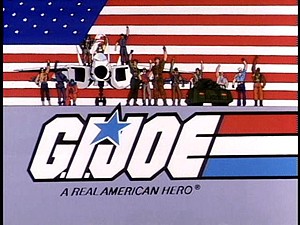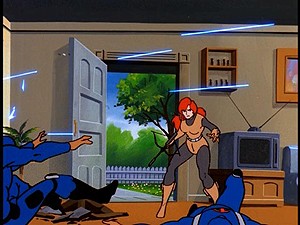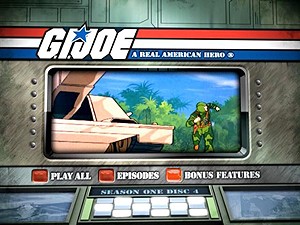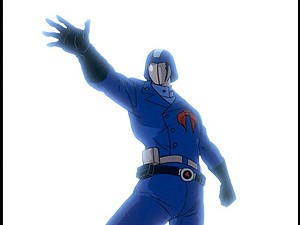| Reviews & Columns |
|
Reviews DVD TV on DVD Blu-ray 4K UHD International DVDs In Theaters Reviews by Studio Video Games Features Collector Series DVDs Easter Egg Database Interviews DVD Talk Radio Feature Articles Columns Anime Talk DVD Savant Horror DVDs The M.O.D. Squad Art House HD Talk Silent DVD
|
DVD Talk Forum |
|
|
| Resources |
|
DVD Price Search Customer Service #'s RCE Info Links |
|
Columns
|
|
|
G.I. Joe The Complete Collection
A chunk of my childhood in a well-constructed box
 Reviewer's Bias*
Reviewer's Bias*
Loves: G.I. Joe, Animation
Likes: the PSAs
Dislikes: the cheesy comedic relief
Hates: Missing out on extras that exist
The Story So Far...
G.I. Joe started life in the '60s as a military toy for young boys, a sort of male-focused Barbie you could dress in various military uniforms and gear. Over the decades, the concept has grown and evolved, taking cues from the times, and expanding into TV and now a live-action movie. Though the toys are probably the most extensive part of the franchise, the cartoon has likely had the largest cultural impact, in large part due to the unique PSAs that followed each episode. Since 2000, there have been several DVD releases of the show's episodes, and DVDTalk has reviews of several available here.
The Show
When I was a little boy, there was one sure sign of status that separated the haves from the have-nots, and it certainly wasn't an iPhone or a PS3. No, back then, what every young boy wanted was his very own aircraft carrier. The U.S.S. Flagg was the single most immense action-figure playset ever, looking more like a piece of furniture than a toy. Seriously, not only did you need to have the money to acquire this behemoth, you also needed a spare room to keep it in. But that was the power of G.I. Joe. Not only did it make us patriotic little soldiers, but incredible capitalist consumers.
Essentially a commercial for Hasbro's new smaller-scaled line of military action figures, the series was probably one of the few examples where commerce and art married beautifully, as the series pushed toys to unsuspecting kids after school like a dealer in the living room. In return, the youngsters got an entertaining and surprisingly complex daily serial depicting the battle between G.I. Joe, an elite special-missions force, and Cobra, a ruthless terrorist organization, along with a bit of street wisdom to boot, thanks to the iconic PSA epilogues. I am probably a perfect example of the series' influence, as I clearly remember hurrying home to catch that day's episode, before heading into the yard to have my own adventures with my 3 and 3/4-inch pals. To this day, I can name far more Joes from 20-plus years ago than current U.S. Senators. But hey, I also know not to touch downed power lines and not to pet strange dogs, so, as with most things, there's a trade-off.
This complete collection includes the two five-episode mini-series that kicked off the show, along with the two seasons produced by Sunbow and Marvel Productions. Therefore, it isn't entirely complete, as the much-maligned third season, produced by DIC, is not included, nor is the straight-to-video movie, which was broadcast as five episodes on TV. While this may anger collectors who want everything Joe, what's here is the G.I. Joe most fans fondly remember (thus you also won't find the unbeloved Sgt. Savage or G.I. Joe Extreme.) With the exception of the third season's Dragonfire run (memorable for the visual of dragons made of fire) I remember little of that series, and since it ditched the continuity and general aesthetics of the Joe universe, it seems right to not be a part of this canon.
 That's just fine, because what you're left with is 95 half-hour military adventures to enjoy, a treasure chest of fun action that rises above its corporate origins on the strength of the writing and design, and a crew featuring some now-legendary names, including Paul Dini, Bruce Timm and Steve Gerber. The show is at its best when Cobra, led by a triumvirate of evil in the blustery, buffoonish Cobra Commander, suave weapons dealer Destro and smooth villainess Baroness, hatches some grandiose scheme to take over the world (normally through some overly complex mechanism) and the Joes step in to stop them. Now that may seem like the plot for every episode, but there's a good deal of variety in the storylines, or at least enough to result in some uniquely interesting shows and some uniquely odd ones too. Only by watching the shows in such a large quantity does it become apparent that the team concept is mostly limited to the mini-series, as the regular episodes tend to focus on one Joe or a small squad. As a result, character will disappear off your radar for long stretches, like Snake Eyes, who, despite his overwhelming popularity, is barely in the show after a while.
That's just fine, because what you're left with is 95 half-hour military adventures to enjoy, a treasure chest of fun action that rises above its corporate origins on the strength of the writing and design, and a crew featuring some now-legendary names, including Paul Dini, Bruce Timm and Steve Gerber. The show is at its best when Cobra, led by a triumvirate of evil in the blustery, buffoonish Cobra Commander, suave weapons dealer Destro and smooth villainess Baroness, hatches some grandiose scheme to take over the world (normally through some overly complex mechanism) and the Joes step in to stop them. Now that may seem like the plot for every episode, but there's a good deal of variety in the storylines, or at least enough to result in some uniquely interesting shows and some uniquely odd ones too. Only by watching the shows in such a large quantity does it become apparent that the team concept is mostly limited to the mini-series, as the regular episodes tend to focus on one Joe or a small squad. As a result, character will disappear off your radar for long stretches, like Snake Eyes, who, despite his overwhelming popularity, is barely in the show after a while.
Among the true stand-outs are the four mini-series, including the globe-spanning five-part "Arise, Serpentor, Arise!" which somehow makes a 100-plus minute kids show fly by, as it tells the story of Cobra's effort to compile the DNA of history's greatest conquerors in order to clone an ultimate Cobra emperor to lead them to victory. A touch sci-fi and a whole lot of the bad guys at their best, the series is as compelling today as it was then, as we get to see how dangerous the organization is with Cobra Commander on the sidelines. With so much space to play with, yet still required to make each segment stand on its own, these storylines have some of the best qualities of the old serials, complete with cliffhangers that made the wait until the next afternoon unbearable.
The plots also had some twists that were different than your usual afterschool series, like "The Traitor," a two-parter with a financially-strapped Joe who sells out to Cobra to help his sick mother, and another two-part episode "Worlds Without End." A sort of "Days of Future Past" for the series, it puts a group of Joes in an alternate universe where Cobra has succeeded in taking over the world. It's easily the darkest story in the series, and probably darker than any mainstream kids cartoon this side of the Transformers movie, as several Joes face their own mortality in the face and some severe sacrifices are made. Though the PSAs are the memorable elements of the series, it's stories like this, and "Eye for an Eye," where a civilian whose family is injured in a Cobra attack goes out for revenge, that show was the series could do at its pinnacle.
When the series tripped up though, it fell hard, sometime crushing a litter of puppies on the way down. Frequently this was because of someone's bright idea to mix military action with fantasy and sci-fi, giving us flights of fancy that put the Joes up against Egyptian gods, giant veggies or ancient Greeks, while one episode regresses the crew into little kids. And the less said about the Cobra telethon, with a stand-up performance by Destro, the better. It certainly feels like the second season plots involved a lot of stretches, after the daily first season burned a lot of good material quickly, with "The Viper is Coming" being the biggest example of "you've got to be kidding" stories, basing an entire episode around an awful old joke about accents.
Even when the show's premise wasn't goofy (Cobra shrank the troops and delivered them in toys to Joe headquarters?) the constant wisecracks and overplayed reliance on disguises will have you rolling your eyes. The one-liners used are right out of the Catskills Comedy handbook, to the point where you're waiting for a rimshot, while the off-heard episode-ending gags make the show into a sitcom. Then there's the disguised. Sure, three of the characters are masters of disguise, but these characters dress up so frequently, the combined budget for latex and spirit gum between G.I. Joe and Cobra must be close to the real U.S. military budget. It got to the point that anyone who didn't appear in the opening titles was instantly suspected to be Zartan or a Joe who minored in theater.
As an adult, there's a lot about the show that comes off as simply lazy, with plot holes all over the place, the biggest of which is the terrible marksmanship from both the Joes and Cobra. How they manage to shoot at each other from short distances and never ever hit the target is ridiculous. The fact that Cobra even exists is equally silly when one considers how often the heads of the group's factions double-cross each other. Or, how about the problem with a secret organization like Cobra having multiple Taj Mahal-sized headquarters covered in giant cobras? That shouldn't be hard to spot. Even Cobras' terrorist missions are frequently questionable, focusing on getting control of a shipping company or fixing a city election, instead of, say, global domination. But hey, I wasn't thinking about such things when I was pint-sized, and it does nothing to think that way now.
Speaking of past perspective, in the earlier part of the decade, I would frequently bemoan the quality of popular TV kids animation, looking at the low-budget, detail-less art and, like an old man lecturing the punks on my lawn, point to shows like G.I. Joe as the way they no longer make cartoon. But I hadn't watched many episodes, so in approaching this set, I didn't know if the art would disappoint, as memories tend to get fuzzed by time and nostalgia. Fortunately, the show does look pretty darn good, sporting an animation style that mixes a touch of American comic art into an anime look that will be familiar to anyone who watched the imports of the 70s, like Speed Racer or Gigantor. The thing that puts this series into an upper tier is the amount of detail in the art and the design work that went into the characters and their vehicles (likely a collaboration with the good people at Hasbro.)
But though fans slag the DIC version of the show, oddly there are episodes here that look like it was "Bring Your Kids to Work Day" at the studio, with the worst offender being "Battle for the Train of Gold," which is laughably bad. Sure, the series didn't boast the most fluid character movement, but in this episode, battle is herky jerky at best (with one brawl looking as smooth as the Peanuts Christmas dance scene) and there are drawings so awkward they could only have been done in Microsoft Paint. Issues with proportions and just plain poor or lazy illustration are also evident in several episodes, making one wonder how a series can be so inconsistent, swinging from beautiful to pathetic. These problems look especially bad following the show's smooth, explosion-packed opening sequences, which feature some of the finest action animation to this day.
 The DVDs
The DVDs
The 95 episodes that make up this collection are spread over 17 DVDs, with between five and seven episodes per disc, along with a bonus disc for each season. The discs are split between two thick digipack books the height and length of a compact disc jewel case, with nine discs in one and eight in the other (plus an open tray that's labeled to hold your separately-sold copy of G.I. Joe the Movie, neatly completing the package.) The two digipacks sit in a pocket under a shelf in the sweet foot locker that holds the whole package. Open the solidly-built package's metal latch and lift the cover (with a window for the show's logo,) there's an embossed plastic shelf with the aforementioned logo and art from the show. Using a small cut-out for your finger, you can lift the surprisingly heavy shelf, and reveal the goodies underneath. The shelf will stay up if you brace it my catching the edge of the box, otherwise the discs make it slam shut. In terms of functionality and sheer presence, it's a great piece of packaging that will keep your set safe from Cobra.
The discs themselves (which use the old toy packaging illustrations for disc art) feature nicely active animated, full-frame menus, with options to watch all the episodes, select shows and, where applicable, check out bonus features. When you select "play all" on any discs with multi-part episodes, you are offered the option to watch them seamlessly, which removes the credits and opening titles from connecting episodes (though the commercial-break bumpers remain in place (annoyingly after watching them for several episodes.) There are no options for audio or subtitles, nor are there closed captions.
The Quality
The full-frame transfers on these episodes look quite nice overall, surprisingly so in spots (mostly in the second season) as the colors are bright, and the image is solid overall, with nice detail and clearly-visible paint strokes (for that old-school feel.) The earlier episodes show a good deal of visible dirt and damage, though it's not overwhelming, normally seen as part of cels moving on top of the action, so the dirt moves with it. These concerns decrease as the series moves on though. Impressively, the normal pixilation issues that plague traditional animation on DVD aren't excessive here and there are no obvious problems with compression artifacts.
After Rhino went all out with the audio on their DVDs, offering the original mono mixes, along with new Dolby Digital 2.0 and 5.1 presentations, the fact that this set only includes 2.0 tracks is bound to be disappointing. Once you get past the disappointment though, the center-balanced 2.0 mixes are very nice, with strong music and sound effects (I'd forgotten how iconic the score is), as well as clean, clear dialogue.
The Extras
Let's start with the non-DVD extras, which include a 60-page booklet with art from the series, an episode guide and a short intro from actor/action figure manipulator Seth Green, in which he confirms (again) he's a member of the Hasbro generation. There's also removable tattoos of the G.I. Joe, Cobra and Arashikage symbols, which are of questionable and limited use to anyone who can afford this set, though it should be noted that they are some of the biggest removable tattoos ever.
Similarly designed magnets, like the Autobot and Decepticon logos in the Transformers complete collection, would have been more welcome, but considering the other physical extra included, a 1gb G.I. Joe dog-tag thumb drive, the trade-off is fine. It's not the most-finely constructed flash drive ever, clad in mirror silver and black plastic, printed with a black G.I. Joe logo and hung on a traditional metal-bead necklace, but as a bonus, it's pretty sweet, and as an additional bonus, it comes loaded with a pair of eight-page comics, one starring Snake Eyes, the other Storm Shadow.
These are silent short stories, told without word balloons or narration, obviously inspired by the classic silent issue of the Marvel G.I. Joe comic book. They don't come close to reaching that standard, especially with just eight pages each, though the art, based on the live-action movie character designs, is nice. The comics are presented as a Flash file that let's you choose a comic and flip through it or watch a slideshow of the pages (which moves a touch too fast.) The pages themselves are in a separate folder in standard image folder, so you can view them in a larger size with your image previewer or repurpose them if you like. Similarly, the fourth disc has a printable script, in PDF format, for a Dini episode, "Jungle Trap," with handwritten notes (who's they are is unmentioned.) What's especially interesting are the notes that are attributed to Hasbro, so you can see the company's influence, though the changes can be hard to read, as the original text is strongly crossed out.
Spread over three discs is the three-part "Looking Back with Writer Ron Friedman," which runs for a combined 19 minutes. As the series' first guiding voice and the architect of the opening description that's seared into fans' brains like the Lord's Prayer, he's got a unique view of the series, and talks about the knowledge of young viewers he brought to the show, how he was brought on board and his personal legacy from the series. Just wait until he starts on voice acting and shows his own wide range of talents.
At 25 minutes, "Men & Women of Action: Creating the G.I. Joe Animated Series" is a tight, engaging overview of the history of the cartoon, calling on cast and crew from the show and comics and staff from Hasbro to talk about the series' origins, how the episodes were made and thoughts about the stories and characters. The honesty about how wacky the series got is appreciated, as discussion of the more fantastical episodes confirms some assumptions regarding their development. If you want to go back a bit further, "Everyday Heroes: The History of G.I. Joe" a 21-minute look-back at the character's start in the '60s to its rebirth in the '80s and the return in the newmillennium (though there's some repetition from the other featurettes. The "1963 Toy Fair Presentation" (nine minutes) ties in with this history, as it introduces the previously-unknown concept in a video loaded with marketing speak that basically declares the idea a can't miss.
Though it may not appeal to casual fans of the series, "Voices of a Real American Hero" spends 33 minutes with eight of the veteran actors who performed on the series, and ends up with a fantastically interesting discussion about the art of cartoon voices, with some small notes on the series itself. If you have any interest in animation, this is a great featurette to check out, as these men (and one woman) reminisce about the recording booth, and discuss some bigger-picture topics, like the series' portrayal of evil.
"Greenshirts: The G.I. Joe Legacy" is a 12-minute exploration of the cartoon's fan base, featuring street interviews with now-adult viewers and sit-downs with Hasbro staff who work on the G.I. Joe brand and crew from the show. Mostly it's about who their favorites were and why the show reached and still reaches fans, giving the people who made the show such a success a spotlight, including some talk about the PSAs, a look at the conventions and a bit about Seth McFarlane's callbacks to the show on his series. The marketing talk is a bit much, but hey, the show started as a commercial.
The focus turns more to the comic book version of G.I. Joe in the 11:23 "Declassified: A conversation with Larry Hama," an interview with the man who probably influenced the concept more than anyone as the chief writer on the comic series, covering how he got the job, the challenges of writing the book, his style of work and his classic "Silent Interlude" issue.
The show's commercial appeal was always supported by real commercials, and you get 25 of them here. The blurry-faced kids (probably a legal clearances issue) actually play with their toys the same way I did, which you don't see much of now in toy commercials (when you do see toy commercials.) The thing that's most interesting about the ads is the way Cobra toys get almost as much of a spotlight as the good guys do, which seems a touch unusual, since in action-figure circles, villains are usually just cannon fodder.
The hugely memorable PSAs that followed each episode are one of the most popular parts of the show, even if the reason for enjoying them isn't always honorable. On these DVDs, you'll get 27 of them, spread amongst four discs, which sadly is not the complete set, as there are seven more not included. These are fun to watch today still, and admittedly, the info is still solid.
A nice, unexpected inclusion wrapping up the extras is the 11-minute fan film Battle for the Serpent Stone, directed by TV editor Sean Olson. The usual suspects, including Snake Eyes and the Baroness, are chasing a hidden relic in this well-done short, which is only really given away as amateur by the costumes. Otherwise, it's pretty obviously the work of a skilled filmmaker.
Aside from the bonus content on the previous Rhino sets (and likely owned by Rhino,) including interviews and alternate footage from the show, the only thing missing that should have been included (if Hasbro has a sense of humor and there are no rights issues) are the fantastically hilarious PSA redubs done by Eric Fensler. Just thinking about "stopping all the downloading" has a smile on my face. A bonus looking at the post-Sunbow incarnations of the Joes would have been pretty cool as well.
 The Bottom Line
The Bottom Line
I'll fully admit that G.I. Joe cartoons don't excite me the way they did when I was a kid, as the comedic relief is more cheesy than funny, and the holes in plots and simple common sense are unavoidably evident. But the stories still entertain (more so when seen through nostalgic eyes) and though the animation can be a touch simpler, the stories are far more complex than what kids are spoon-fed today. Even the PSAs hold up well, with lessons kids should know, even if the delivery is a bit cheesy. Obviously, this is a massive collection and a major investment, but it certainly feels like it's worth it when you have it in front of you, in terms of the wealth of episodes, bonus features and simple physical presentation (though the content missing from previous sets is a let-down.) The initiated will want to go with one of the smaller sets to start, but for a true fan, this is a blast from the past.
Francis Rizzo III is a native Long Islander, where he works in academia. In his spare time, he enjoys watching hockey, writing and spending time with his wife, daughter and puppy.Follow him on Twitter
*The Reviewer's Bias section is an attempt to help readers use the review to its best effect. By knowing where the reviewer's biases lie on the film's subject matter, one can read the review with the right mindset.
|
| Popular Reviews |
| Sponsored Links |
|
|
| Sponsored Links |
|
|
| Release List | Reviews | Shop | Newsletter | Forum | DVD Giveaways | Blu-Ray | Advertise |
|
Copyright 2024 DVDTalk.com All Rights Reserved. Legal Info, Privacy Policy, Terms of Use,
Manage Preferences,
Your Privacy Choices | |||||||












